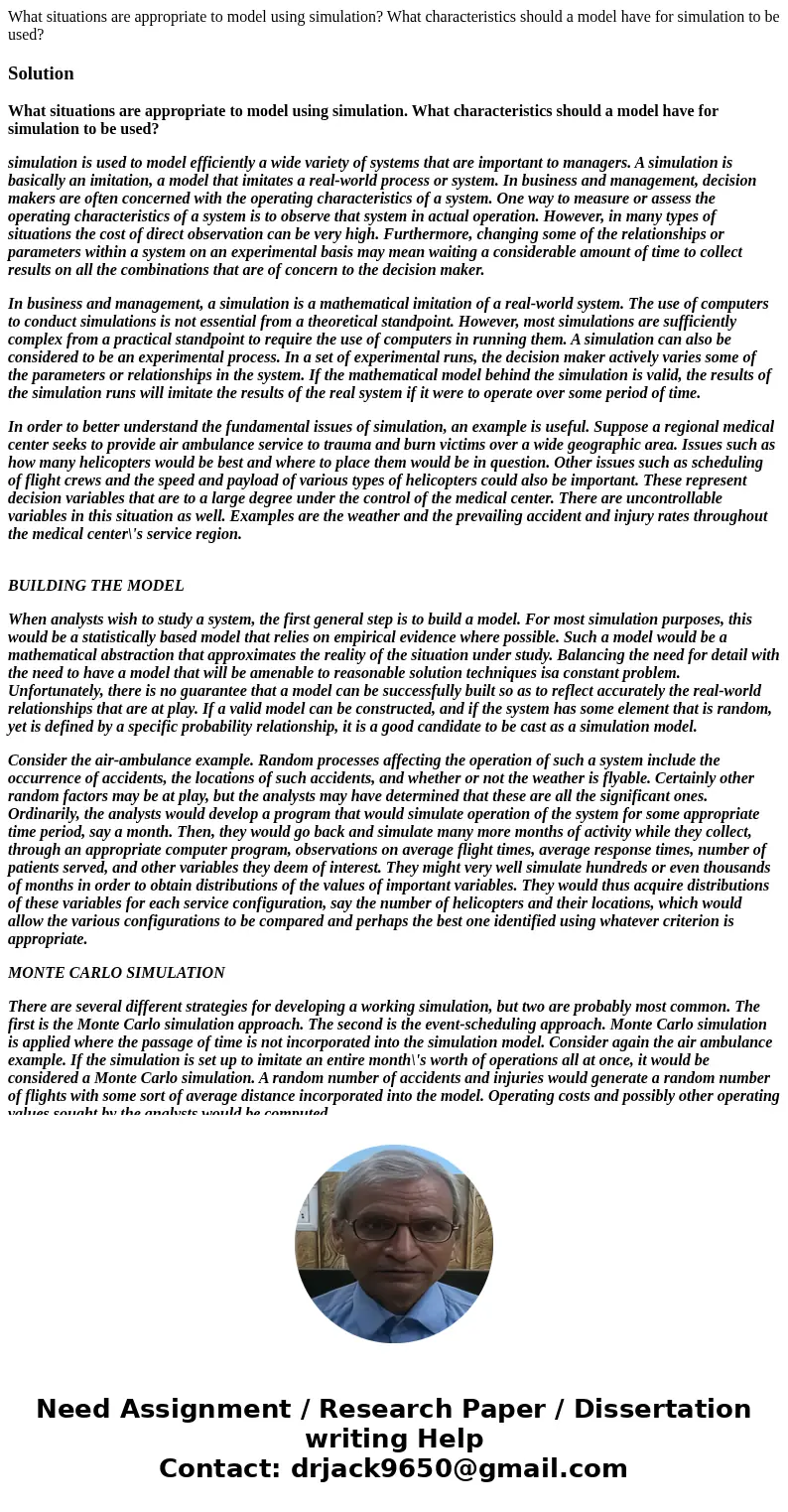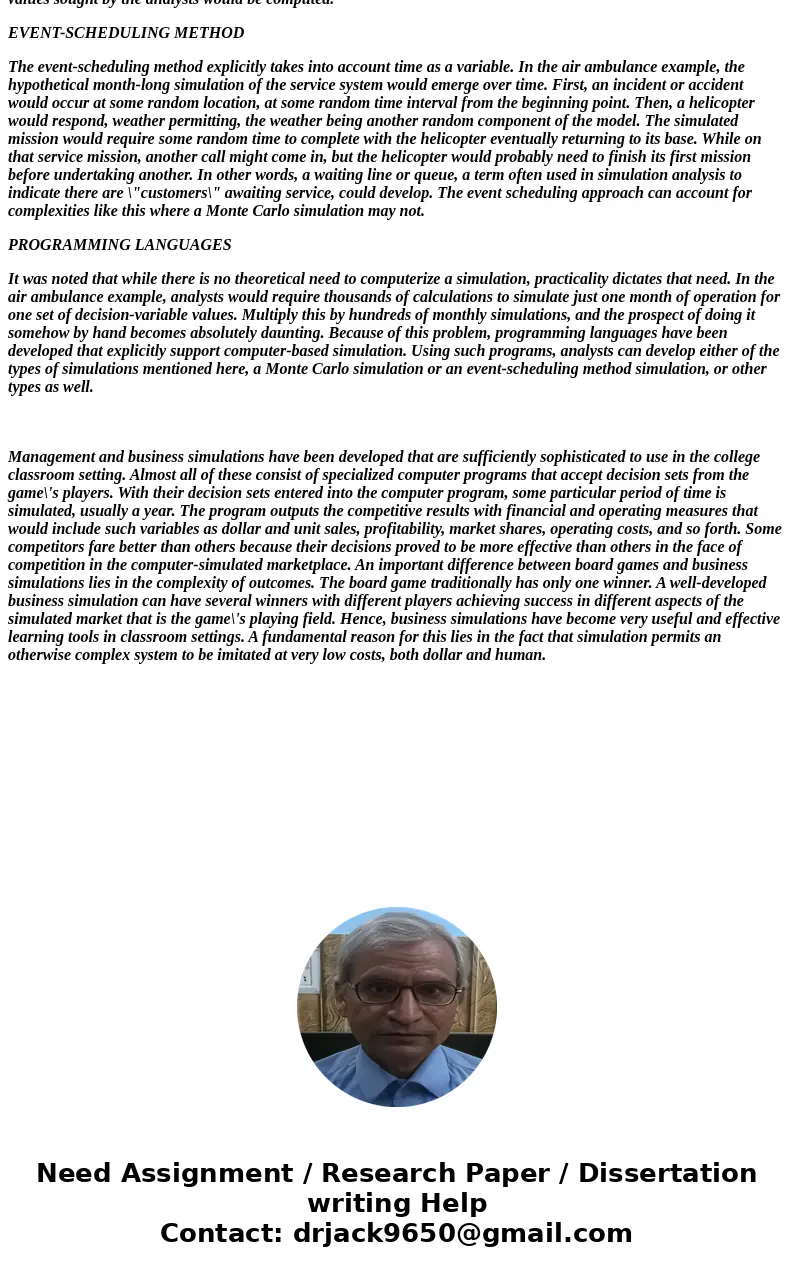What situations are appropriate to model using simulation Wh
What situations are appropriate to model using simulation? What characteristics should a model have for simulation to be used?
Solution
What situations are appropriate to model using simulation. What characteristics should a model have for simulation to be used?
simulation is used to model efficiently a wide variety of systems that are important to managers. A simulation is basically an imitation, a model that imitates a real-world process or system. In business and management, decision makers are often concerned with the operating characteristics of a system. One way to measure or assess the operating characteristics of a system is to observe that system in actual operation. However, in many types of situations the cost of direct observation can be very high. Furthermore, changing some of the relationships or parameters within a system on an experimental basis may mean waiting a considerable amount of time to collect results on all the combinations that are of concern to the decision maker.
In business and management, a simulation is a mathematical imitation of a real-world system. The use of computers to conduct simulations is not essential from a theoretical standpoint. However, most simulations are sufficiently complex from a practical standpoint to require the use of computers in running them. A simulation can also be considered to be an experimental process. In a set of experimental runs, the decision maker actively varies some of the parameters or relationships in the system. If the mathematical model behind the simulation is valid, the results of the simulation runs will imitate the results of the real system if it were to operate over some period of time.
In order to better understand the fundamental issues of simulation, an example is useful. Suppose a regional medical center seeks to provide air ambulance service to trauma and burn victims over a wide geographic area. Issues such as how many helicopters would be best and where to place them would be in question. Other issues such as scheduling of flight crews and the speed and payload of various types of helicopters could also be important. These represent decision variables that are to a large degree under the control of the medical center. There are uncontrollable variables in this situation as well. Examples are the weather and the prevailing accident and injury rates throughout the medical center\'s service region.
BUILDING THE MODEL
When analysts wish to study a system, the first general step is to build a model. For most simulation purposes, this would be a statistically based model that relies on empirical evidence where possible. Such a model would be a mathematical abstraction that approximates the reality of the situation under study. Balancing the need for detail with the need to have a model that will be amenable to reasonable solution techniques isa constant problem. Unfortunately, there is no guarantee that a model can be successfully built so as to reflect accurately the real-world relationships that are at play. If a valid model can be constructed, and if the system has some element that is random, yet is defined by a specific probability relationship, it is a good candidate to be cast as a simulation model.
Consider the air-ambulance example. Random processes affecting the operation of such a system include the occurrence of accidents, the locations of such accidents, and whether or not the weather is flyable. Certainly other random factors may be at play, but the analysts may have determined that these are all the significant ones. Ordinarily, the analysts would develop a program that would simulate operation of the system for some appropriate time period, say a month. Then, they would go back and simulate many more months of activity while they collect, through an appropriate computer program, observations on average flight times, average response times, number of patients served, and other variables they deem of interest. They might very well simulate hundreds or even thousands of months in order to obtain distributions of the values of important variables. They would thus acquire distributions of these variables for each service configuration, say the number of helicopters and their locations, which would allow the various configurations to be compared and perhaps the best one identified using whatever criterion is appropriate.
MONTE CARLO SIMULATION
There are several different strategies for developing a working simulation, but two are probably most common. The first is the Monte Carlo simulation approach. The second is the event-scheduling approach. Monte Carlo simulation is applied where the passage of time is not incorporated into the simulation model. Consider again the air ambulance example. If the simulation is set up to imitate an entire month\'s worth of operations all at once, it would be considered a Monte Carlo simulation. A random number of accidents and injuries would generate a random number of flights with some sort of average distance incorporated into the model. Operating costs and possibly other operating values sought by the analysts would be computed.
EVENT-SCHEDULING METHOD
The event-scheduling method explicitly takes into account time as a variable. In the air ambulance example, the hypothetical month-long simulation of the service system would emerge over time. First, an incident or accident would occur at some random location, at some random time interval from the beginning point. Then, a helicopter would respond, weather permitting, the weather being another random component of the model. The simulated mission would require some random time to complete with the helicopter eventually returning to its base. While on that service mission, another call might come in, but the helicopter would probably need to finish its first mission before undertaking another. In other words, a waiting line or queue, a term often used in simulation analysis to indicate there are \"customers\" awaiting service, could develop. The event scheduling approach can account for complexities like this where a Monte Carlo simulation may not.
PROGRAMMING LANGUAGES
It was noted that while there is no theoretical need to computerize a simulation, practicality dictates that need. In the air ambulance example, analysts would require thousands of calculations to simulate just one month of operation for one set of decision-variable values. Multiply this by hundreds of monthly simulations, and the prospect of doing it somehow by hand becomes absolutely daunting. Because of this problem, programming languages have been developed that explicitly support computer-based simulation. Using such programs, analysts can develop either of the types of simulations mentioned here, a Monte Carlo simulation or an event-scheduling method simulation, or other types as well.
Management and business simulations have been developed that are sufficiently sophisticated to use in the college classroom setting. Almost all of these consist of specialized computer programs that accept decision sets from the game\'s players. With their decision sets entered into the computer program, some particular period of time is simulated, usually a year. The program outputs the competitive results with financial and operating measures that would include such variables as dollar and unit sales, profitability, market shares, operating costs, and so forth. Some competitors fare better than others because their decisions proved to be more effective than others in the face of competition in the computer-simulated marketplace. An important difference between board games and business simulations lies in the complexity of outcomes. The board game traditionally has only one winner. A well-developed business simulation can have several winners with different players achieving success in different aspects of the simulated market that is the game\'s playing field. Hence, business simulations have become very useful and effective learning tools in classroom settings. A fundamental reason for this lies in the fact that simulation permits an otherwise complex system to be imitated at very low costs, both dollar and human.


 Homework Sourse
Homework Sourse